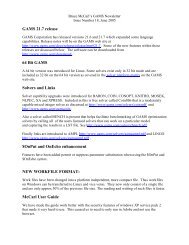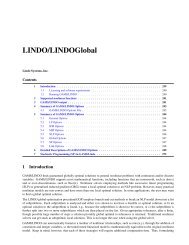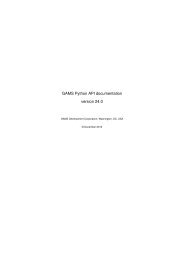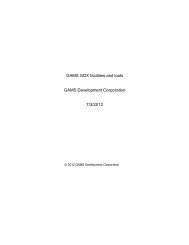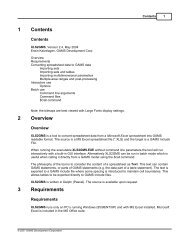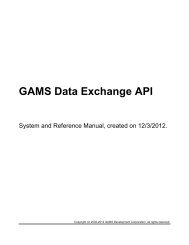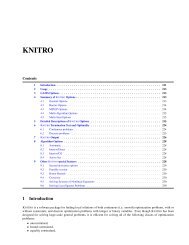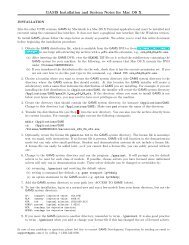- Page 1 and 2: Economic Equilibrium Modeling with
- Page 3 and 4: Demand Theory and General Equilibri
- Page 5 and 6: Demand Theory and MPSGE 3 who are i
- Page 7 and 8: Figure 2. Indi erence Curves and Ut
- Page 9 and 10: Y y = 1 Figure 5. A Calibrated Benc
- Page 11 and 12: O:PX Q:1 I:PL Q:1 $PROD:Y O:PY Q:1
- Page 13 and 14: For this model, the solution listin
- Page 15: MRS = PX.L / PY.L; OPTION MRS:8; DI
- Page 19 and 20: Demand Theory and MPSGE 17 The key
- Page 21 and 22: Demand Theory and MPSGE 19 In GAMS/
- Page 23 and 24: Demand Theory and MPSGE 21 N.B. In
- Page 25 and 26: PY0 = 1; LX0 = 1; $ONTEXT $MODEL:DE
- Page 27 and 28: Demand Theory and MPSGE 25 ---- VAR
- Page 29 and 30: RATE OF SUBSTITUTION Demand Theory
- Page 31 and 32: $PROD:X $PROD:Y I:PLS Q:1 O:PX Q:1
- Page 33 and 34: Demand Theory and MPSGE 31 ---- VAR
- Page 35 and 36: Demand Theory and MPSGE 33 ---- VAR
- Page 37 and 38: $DEMAND:A s:SIGMA_A E:PX Q:XA E:PY
- Page 39 and 40: Demand Theory and MPSGE 37 ---- VAR
- Page 41 and 42: Demand Theory and MPSGE 39 ---- VAR
- Page 43 and 44: Demand Theory and MPSGE 41 SC6 0.77
- Page 45 and 46: MXA TRADE IN X FROM B TO A MXB TRAD
- Page 47 and 48: Demand Theory and MPSGE 45 Suppress
- Page 49 and 50: Applied General Equilibrium Modelin
- Page 51 and 52: MPSGE Syntax 49 selected set of pap
- Page 53 and 54: MPSGE Syntax 51 Final demand are de
- Page 55 and 56: MPSGE Syntax 53 SAM displayed in Fi
- Page 57 and 58: MPSGE Syntax 55 PARAMETER A(S) BENC
- Page 59 and 60: * SECTION (ii) MPSGE MODEL DECLARAT
- Page 61 and 62: MPSGE Syntax 59 is, the user cost o
- Page 63 and 64: ---- VAR CD LOWER LEVEL UPPER MARGI
- Page 65 and 66: LOOP(SC, * INSTALL TAX RATES FOR TH
- Page 67 and 68:
MPSGE Syntax 65 (ii) There are two
- Page 69 and 70:
INDEX 1 = HARBERGER UNIF_K UNIF_L U
- Page 71 and 72:
MPSGE Syntax 69 James R. Markusen a
- Page 73 and 74:
MPSGE Syntax 71 James R. Markusen a
- Page 75 and 76:
MPSGE Syntax 73 price (within the $
- Page 77 and 78:
MPSGE Syntax 75 X0(R) = SUM(G, YX0(
- Page 79 and 80:
7.6. Report Declaration MPSGE Synta
- Page 81 and 82:
MPSGE Syntax 79 FUNLOG triggers a f
- Page 83 and 84:
MPSGE Syntax 81 -------------------
- Page 85 and 86:
MPSGE Syntax 83 or to report percen
- Page 87 and 88:
MPSGE Syntax 85 Market Clearance fo
- Page 89 and 90:
MPSGE Syntax 87 Income Balance for
- Page 91 and 92:
CES Preferences and Technology A Pr
- Page 93 and 94:
CES Functions 91 calibrate function
- Page 95 and 96:
and compensated factor demands: Exe
- Page 97 and 98:
or, equivalently: X CES Functions 9
- Page 99 and 100:
CES Functions 97 $TITLE Two nonsepa
- Page 101 and 102:
* Now specify the two-level CES fun
- Page 103 and 104:
SCALAR DELTA /1.E-5/; SET FUNCTION
- Page 105 and 106:
CES Functions 103 $TITLE Numerical
- Page 107 and 108:
CES Functions 105 SCALAR SOLVED Fla
- Page 109 and 110:
CES Functions 107 $TITLE A Maquette
- Page 111 and 112:
$ONTEXT $MODEL:CHKCAL $COMMODITIES:
- Page 113 and 114:
PL.L = 1.0; CES Functions 111 * CHE
- Page 115 and 116:
Calibration: CES Functions 113 aij
- Page 117:
Calibration: CES Functions 115 ai 0
- Page 120 and 121:
118 1. Introduction GAMS (General A
- Page 122 and 123:
120 This MCP format encompasses a n
- Page 124 and 125:
122 That is: min P ij cijxij s.t. P
- Page 126 and 127:
124 PARAMETER ALPHA(I) Supply funct
- Page 128 and 129:
126 PARAMETER T(I,J) AD-VALOREM TAX
- Page 130 and 131:
128 , 2.t Aggregate world output eq
- Page 132 and 133:
130 POSITIVE VARIABLES E(R) FACTOR
- Page 134 and 135:
132 SET J PLAYERS /J1*J3/, I ACTION
- Page 136 and 137:
134 For these tests, both solvers a
- Page 138 and 139:
136 Consider the following nonlinea
- Page 140 and 141:
138 Associated Equation Type Variab
- Page 143 and 144:
Sequential Joint Maximization Relat
- Page 145 and 146:
Joint Maximization 143 maps prices
- Page 147 and 148:
Joint Maximization 145 Equilibrium
- Page 149 and 150:
OA Figure 1. Equilibrium in a 2x2 E
- Page 151 and 152:
If k =1or ( k ) < ( k,1 ), set k+1
- Page 153 and 154:
so that when 0 = 4, the (JM-D) prob
- Page 155 and 156:
Joint Maximization 153 Let (p; M) d
- Page 157 and 158:
Joint Maximization 155 which reduce
- Page 159 and 160:
Joint Maximization 157 Murtaugh, Br
- Page 161 and 162:
A.1. Two-by-Two Exchange Joint Maxi
- Page 163 and 164:
Joint Maximization 161 * The SJM pr
- Page 165 and 166:
); Joint Maximization 163 p(i) = -
- Page 167 and 168:
Joint Maximization 165 NP = (M+1) *
- Page 169 and 170:
SUM(C, ALPHA(C,H) * LOG(D(C,H)/DBAR
- Page 171 and 172:
OUTPUT.HOUSEOP 0.80 OUTPUT.CAPEOP 1
- Page 173 and 174:
Joint Maximization 171 VARIABLES Y(
- Page 175 and 176:
Joint Maximization 173 D.L(C,H) = (
- Page 177:
); Joint Maximization 175 LOOP(N, E



